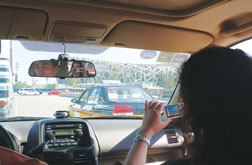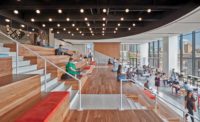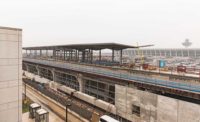 Janice L. Tuchman/ENR National Stadium is already an attraction even to Beijing residents.
|
Yan Wang rushes downstairs from the midrise office building where Parsons Brinckerhoff China has its Beijing office and makes a dash for the sedan her driver has pulled into the courtyard. Her client, the Beijing Organizing Committee of the Olympic Games, has called a last-minute meeting at its headquarters in north central Beijing. Wang is the manager of urban and transportation planning in PB’s Beijing office, and she—of all people—knows it will take at least an hour to negotiate the city traffic.
It is a beautiful blue sky day with roses blooming along the second ring road that allows the car to skirt the central city. Wang snaps a photo as the car passes National Stadium—the already famous Olympic venue nicknamed the Bird’s Nest for its woven steel exterior frame. At the meeting, all the venue managers will give Wang their comments about the pedestrian study that PB has prepared.
|
The irony of a transportation planner with a car and driver is not lost on Wang. But right now, depending on the city’s mass transit “to get to meetings on time is quite risky,” she says, also acknowledging that having a car is a symbol of “means.” The attitude will change, she believes, as Beijing’s bus and rail mass transit system expands. Beijing now has a total of 100 kilometers of subways, but plans to expand that to 561 kilometers by 2015, Wang says. Her team is competing for several subway station design projects, and she expects to hear about the outcome in a few days.
The BOCOG meeting was productive. Wang heard that PB’s traffic study had been complimented. After the meeting she took time to stop at a nearby restaurant with Jack Zhou, her deputy manager, for some local Beijing cuisine—specialty dishes such as lily bulb with chicken and wondo cake.
Wang grew up in Hebei province and came to Beijing at age 17 to go to Northern Jiaotong University, where she got undergraduate and master’s degrees in transportation management and engineering. Then she came to the U.S. to study at the University of Wyoming, where she received a doctorate in 1995. She started working for PB in its Atlanta office, working on rail corridor expansion feasibility studies and Hartsfield International Airport travel demand modeling.
 Janice L. Tuchman/ENR Wang manages two calls at once.
|
Back in the office, Wang is about to settle in to the real work of the day, when she remembers an in-house meeting she has to attend. PB Vice President Xi Fei, director and general manager of the North China Region, is briefing his team on the recent Asia managers’ meeting.
Finally, the proposal. Wang is leaving on a trip to Australia the following Monday to meet with a client about route optimization for a heavy rail line. She confers with a staff engineer about getting the rates set and making arrangements with partners on the project.
She puts in a call to PB International to advise that she will be traveling out of her region—when her cell phone rings. No big deal...Yan picks it up and proceeds to talk on two phones at once. Cell phones and text messaging are a vital part of business life. “We text short messages to clients,” she says. “They don’t look at e-mail.” The second call brings work for the weekend: She will have to review the closeout of a completed project and “put the lid on it.” And of course, she will have to pack for the trip—warm clothes for winter in Perth.

 A Day in the Life of Yan Wang
A Day in the Life of Yan Wang 


Post a comment to this article
Report Abusive Comment